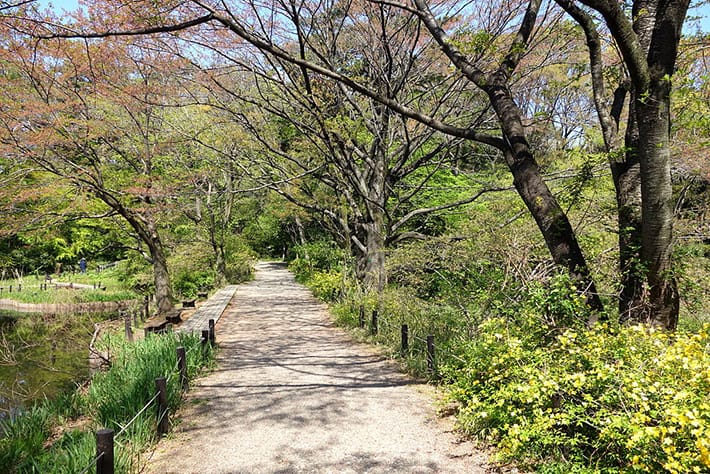he summer months in Tokyo, when the cicadas are at their loudest and even the greenery seems to be wilting in the heat, are an annual reminder that Japan's capital was once a tropical jungle. You might not think so looking out across a panorama of concrete, glass, and tarmac, but if it were ever to revert to its natural state, the city would be a steaming forest of towering trees, verdant undergrowth, and countless millions of creepy crawlies.
There are a handful of parks created for the preservation of nature in Tokyo, but the ancestral desire to deny its primordial strength is such that even up as parodies of wilderness. The city's biggest parks—Ueno, Shinjuku Gyoen 新宿御苑, Hibiya 日比谷, Toyama 戸山, and the like—purport to give residents a taste of nature in the raw but they are no less artificial than the city they offer refuge from. To compare any of them to the state of nature in Tokyo before the arrival of humankind would be like comparing a poodle to a wolf.
Chances are that even an escape to the Japanese countryside will leave you with a taste of saccharine. It's often said that 70% of Japan is forested, but most of its native tree cover was cleared in the post-war years to make way for Sugi (Japanese cedar) plantations. These days, with the building boom over, there's not much call for all those cedar trees, and their main purpose seems to be to give everyone hay fever.

There is, however, one place, where you can see the Tokyo landscape as nature intended: the National Institute for Nature Study (国立科学博物館附属自然教育園 kokuritsu kagaku hakubutsukan fuzoku shizen kyōikuen) in Shirokanedai 白金台 in Minato Ward 港区. This nature reserve is home to more than 200 species of plants, representing much of the native flora of the Musashino 武蔵野 region.
There are broad-leafed evergreen trees in their natural state, and native conifers like sweet acorn tree, bamboo-leaf oak, and pine. In the centre of the reserve is Bottle Gourd Pond (ひょうたん池 hyotan ike), named for its shape, which resembles a hyotan 瓢箪 (bottle gourd). A forest path takes you around the pond, meandering under the branches of oak, zelkova, and dogwood trees and offering restorative views over the marshes to the east.
Marshes and the creeks that feed them once covered much of the delta of the Sumida River 隅田川. The reeds and Japanese silver grass that used to blanket the landscape crop up time and time again in Edo era novels and plays.
The National Institute for Nature Study is also home to 130 bird species, among them the spot-billed duck and the snowy heron. They congregate around Waterfowl Marsh (水鳥の池 mizudori no ike), the largest of the marshes in the reserve.
There are also many native animals that would otherwise have been confined to folklore, such as tanuki 狸 (Japanese raccoon dogs), kitsune 狐 (foxes) and oshidori 鴛鴦 (mandarin ducks). The reserve also abounds in insect life.

The National Institute for Nature Study is a good approximation of pre-human Kanto, but it's not quite the real thing. In the early years of the Edo period (1603-1868), the area occupied by the reserve was cleared for rice paddies. In 1664, it was given to Matsudaira Yorishige 松平頼重, the daimyō of Takamatsu 高松, who had a pleasure garden laid out. Along with Bottle Gourd Pond, some of the oldest pine trees on the estate are thought to date back to this time.
Following the Meiji Restoration in 1868, the daimyo's estate was confiscated and given to the Army, which used it as a gunpowder magazine. Then it was given to the Imperial Household Agency, and during World War II it was used to grow rice again and several air raid shelters were dug.
After the war, the estate was given to the Ministry of Education, which opened it to the public as a national natural education park. It became part of the National Museum of Nature and Science 国立科学博物館 and was renamed the National Institute for Nature Study in 1962.
The National Institute for Nature Study is open from 9:00 to 17:00 (but only until 16:30 between September and April), and the last entry is at 16:00. It is closed on Mondays (or the following day if Monday is a national holiday), the day after national holidays (except Saturdays and Sundays), and between December 28 and January 4. Admission is 320 yen for adults and college students and free for students through high school (or vocational school).
It is located in Shirokanedai in southwest Tokyo, about a 10-minute walk from Meguro station 目黒駅 on the JR Yamanote line 山手線. For more information, see the Institute's website.
Read more stories from grape Japan.
-- Autumn Japanese bamboo flute performance to be held at luxury hotel Aman Kyoto
-- Where to enjoy yakitori and yakiton under the tracks at Shinbashi
- External Link
- https://grapee.jp/en/
 Take our user survey and make your voice heard.
Take our user survey and make your voice heard.















3 Comments
Login to comment
GBR48
It's nice. It is densely wild enough to blot out the urban noise and makes for a pleasant walk through the woodland to the pond. There is a small shop with nature-related educational goodies for sale.
Tokyo Metropolitan Teien Art Museum is nearby. It has two gardens, one of which has a pond and a tea house. The expressway is a bit close, but it is still pleasant and a good place to take photographs.
These can be combined with a trip to Daienji Temple. It is full of statues, ancient and modern, and sits half-way down one of the steepest roads in Tokyo.
Chabbawanga
We need so much more of this. Land tax should be wavered fr anyone who turns disused land into a park.
Zaphod
I live near there. It is a really great place, you can forget that you are in big city.